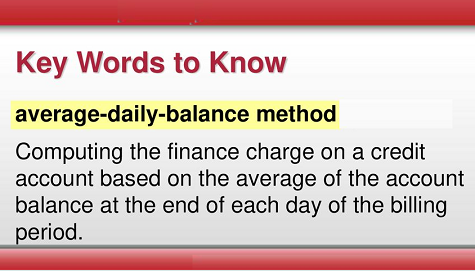Section 7-3 Finance Charge: Average-Daily-Balance Method (No New Purchases Included)
Section 7-3: Average-Daily-Balance Method (No New Purchases Included)
Overview

 The average daily balance method, excluding new purchases, is one of the ways creditors calculate finance charges on credit card balances. It's a method commonly used by credit card issuers to determine the interest charges incurred on outstanding balances when no new purchases are made during the billing cycle. Here's how the average daily balance method (no new purchases included) works:
The average daily balance method, excluding new purchases, is one of the ways creditors calculate finance charges on credit card balances. It's a method commonly used by credit card issuers to determine the interest charges incurred on outstanding balances when no new purchases are made during the billing cycle. Here's how the average daily balance method (no new purchases included) works:
Calculation Period: Credit card issuers typically calculate finance charges on a monthly basis, known as the billing cycle. For this method, the calculation excludes any new purchases made during the billing cycle.
Average Daily Balance: To determine the finance charge using the average daily balance method (no new purchases included), the average daily balance of the credit card account is calculated for the billing cycle. The average daily balance is the sum of the outstanding balances on each day of the billing cycle divided by the number of days in the cycle.
Daily Interest Rate: The credit card's annual percentage rate (APR) is divided by the number of days in the year to determine the daily periodic rate. This daily interest rate is then applied to the average daily balance to calculate the daily finance charge.
Accumulated Finance Charges: The daily finance charges incurred during the billing cycle are accumulated to determine the total finance charge for the period. This total finance charge is added to the outstanding balance to determine the new balance due.
Example: Let's say you have a credit card with an APR of 18% and a billing cycle of 30 days. If your average daily balance for the billing cycle is $1,000, the daily periodic rate would be calculated as follows:
Daily Periodic Rate = (Annual Percentage Rate / 365) * 30
Daily Periodic Rate = (0.18 / 365) * 30 ≈ 0.01479%
If we round it up, the daily periodic rate would be approximately 0.015%.
The daily finance charge would then be:
Daily Finance Charge = Average Daily Balance * Daily Periodic Rate
Daily Finance Charge = $1,000 * 0.00015 ≈ $0.15
If the billing cycle is 30 days, the total finance charge for the cycle would be approximately $0.15 * 30 = $4.50.
Please note that this is a simplified example, and actual finance charges may vary based on factors such as the timing of transactions and any promotional or introductory interest rates. Additionally, the method used to calculate finance charges may vary between credit card issuers.
Videos (Click on Image to View Videos)
Online Textbook Read Section 7-3: Finance Charge: Average-Daily-Balance Method (No New Purchases Included)
